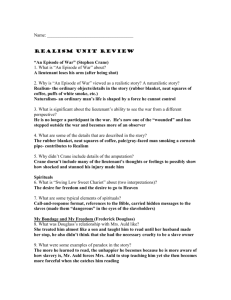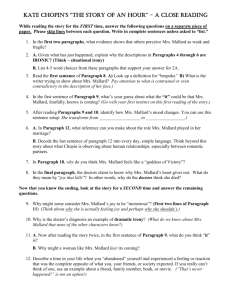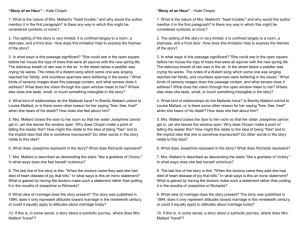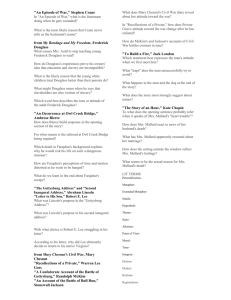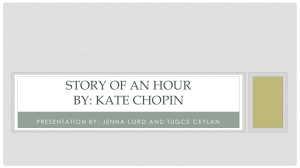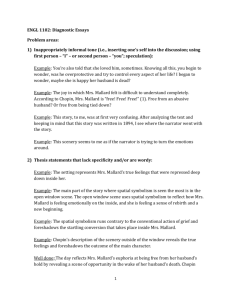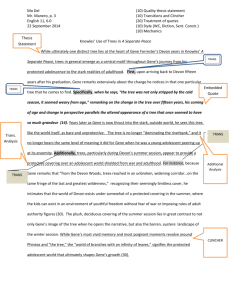Student Essay
advertisement
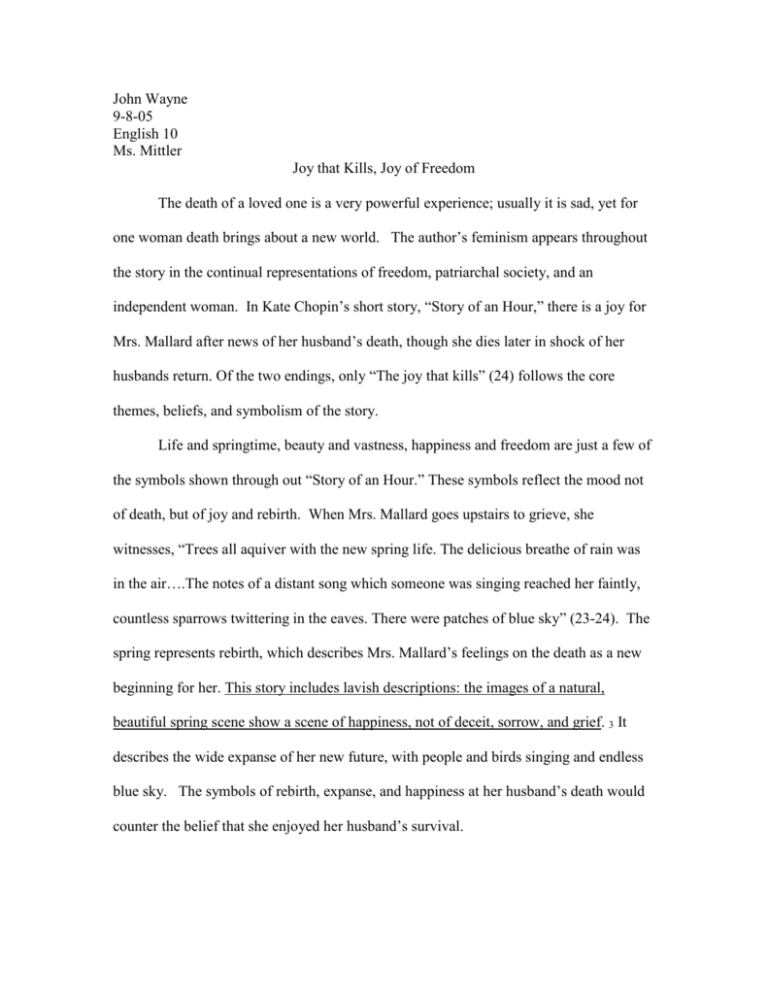
John Wayne 9-8-05 English 10 Ms. Mittler Joy that Kills, Joy of Freedom The death of a loved one is a very powerful experience; usually it is sad, yet for one woman death brings about a new world. The author’s feminism appears throughout the story in the continual representations of freedom, patriarchal society, and an independent woman. In Kate Chopin’s short story, “Story of an Hour,” there is a joy for Mrs. Mallard after news of her husband’s death, though she dies later in shock of her husbands return. Of the two endings, only “The joy that kills” (24) follows the core themes, beliefs, and symbolism of the story. Life and springtime, beauty and vastness, happiness and freedom are just a few of the symbols shown through out “Story of an Hour.” These symbols reflect the mood not of death, but of joy and rebirth. When Mrs. Mallard goes upstairs to grieve, she witnesses, “Trees all aquiver with the new spring life. The delicious breathe of rain was in the air….The notes of a distant song which someone was singing reached her faintly, countless sparrows twittering in the eaves. There were patches of blue sky” (23-24). The spring represents rebirth, which describes Mrs. Mallard’s feelings on the death as a new beginning for her. This story includes lavish descriptions: the images of a natural, beautiful spring scene show a scene of happiness, not of deceit, sorrow, and grief. 3 It describes the wide expanse of her new future, with people and birds singing and endless blue sky. The symbols of rebirth, expanse, and happiness at her husband’s death would counter the belief that she enjoyed her husband’s survival. Chopin’s story contains many themes and beliefs including rebirth, feminism, self-reliance, and freedom. In a moment of true ecstasy of her freedom and rebirth Mrs. Mallard walks down the stairs before her death, yet after her revelation-“There was a feverish triumph in her eyes, and she carried herself unwittingly like a goddess of Victory” (24). Victorious over the patriarchal society, Mrs. Mallard has become a free, self sufficient soul. Through her unique view on Mr. Mallard’s death, Mrs. Mallard has become a symbol of feminist ideals, the independent, free, and self-reliant woman. These themes and beliefs show that Mrs. Mallard has accepted her husband’s death and moved on; she is glad to be rid of the institution of marriage1. Most would dwell on the past after death; Mrs. Mallard, the future. 2 So, Mrs. Mallard has no joy in seeing her husband’s return, her joy springs from his death by its creating her freedom. It is the absolute ecstasy, triumph, and joy that bring her demise. She looks past the death to her future life, but with Mr. Mallard’s return, this amazing life disappears. “There would be no powerful will bending hers in the blind persistence with which men and women believe they have a right to impose a private will upon a fellow-creature. (24)” It was this life, with no one else tying Mrs. Mallard down, no one else imposing their will upon her, no one else to agree with that Mrs. Mallard now sees. But, Mrs. Mallard cannot bear to return to that, now simple, regular, horrid, lifestyle. Her joy, her reason for living, becomes her glimpse at the life without Mr. Mallard, so his return produces an unlivable circumstance. Her triumph over marriage and society are crushed because she is forced to return to society, which she learned so quickly to hate. It is this crushing blow that utterly shatters Mrs. Mallard, killing her. “Story of an Hour” has a very vague ending; however, the cause of Mrs. Mallard’s death was due to the loss of her sheer joy, freedom and a new life. Mrs. Mallard, in the end, frees herself forever of social constraints and her married life even if it is through death. Chopin is showing the readers that freedom from the patriarchal society is worth dying for. Works Cited Chopin, Kate. "Story of an Hour." Insights to Identity. San Deigo: University Readers, Inc., 2005. 23-24. Note 1- Sentence pattern 1 2- Sentence pattern 2 3- Sentence pattern 3
